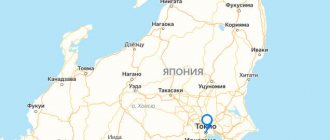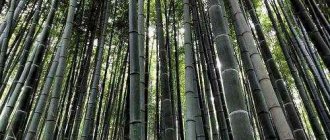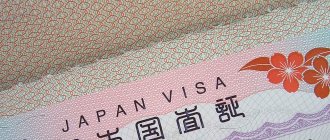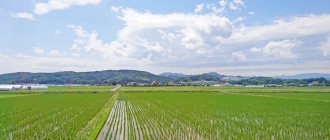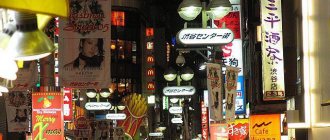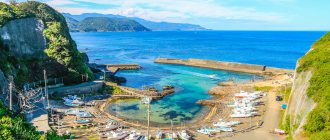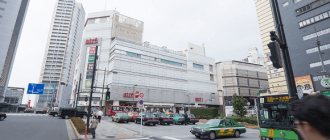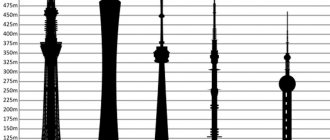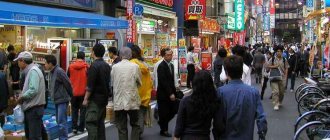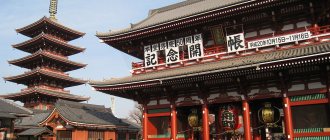Let's immediately say that Tokyo's nightlife is concentrated in several areas: Roppongi, Kabuki-cho and Ginza. Here every tourist can find entertainment to suit their taste. Restaurants, bars, clubs, striptease and sex shows greet you with bright signs and Western-style names: “The Room”, “Jumanji 55”, “Green Land” and others. There are also authentic Japanese establishments, for example Nomi-ya-bars - small, sometimes ridiculously narrow establishments where you can enjoy delicious and unusual Japanese dishes.
But let's get back to the real nightlife and leave all these delicacies for another time.
Prices
So, on to the prices. Entrance to most establishments is free, but as elsewhere, there are clubs with entrance fees, often not exceeding a couple of hundred yen. Be prepared to shell out 500 yen (~$5) for a cocktail at a regular bar.
The average price for one drink in a night drinking establishment in Tokyo is 600-800 yen ($6-8). Based on this, a logical question follows: “What should a budget partygoer do?”
Immediately forget about the option that many CIS clubs turn a blind eye to - bringing alcohol with you. This number does not work here. But no one forbids you to come to the party already a little “happy.” Prices for beer in the supermarket start from $1.6, a half-liter bottle of whiskey will cost you from $20, while sake can be purchased for $10!
By the way, in Japan it is considered the norm not to sit in one club/bar all night, but to visit 2-3 or even more establishments during this time.
It is worth noting that nightlife is different for visiting adventurers and the Japanese themselves. The Japanese are accustomed to spending time in bars or hostess clubs (more about them below), while most tourists enjoy discos and other more active events.
Japanese club names
The correspondence in the comments with the respected ivm became the impetus for this long overdue post. There are practically no regular publications about Japanese football in Russian, and therefore there is no established tradition in translating the names of local clubs. The following list is my attempt to fill this gap and create a guide of sorts to Japanese football names.
First, a little general information. Japanese football clubs are named according to the same principle as in the rest of the world: the club's own name and the name of the city or region in which it is based. The “name-city” order is more traditional and familiar, but is not mandatory; There are also clubs named according to the “city-name” scheme. Specific abbreviations like FC or SC may or may not be added; they are required only when the name of the club coincides with the name of the city, such as FC Tokyo. In texts they are naturally omitted; from the context it is already clear that we are talking about a football club, and when you need to emphasize the difference with the city, quotation marks come to the rescue - just as in all similar cases for other countries.
Almost all the names of the clubs are of foreign origin - football has not remained aloof from the general Japanese fashion for everything “Western”. Borrowings are carried out haphazardly, the main thing is to sound beautiful and impressive, and the Japanese are no longer very concerned about the fact that some rules of the barbaric language are being violated. As a result, words are often twisted to suit Japanese pronunciation/spelling or simply “for beauty”; the name can be an unthinkable word-word, in particularly advanced cases even interlingual... in general, complete freedom of expression.
However, it is quite possible to restore some semblance of order in this chaos if you approach the issue wisely. I was guided by the following simple rule: a foreign name is transcribed according to the language of origin, but the main task is to get a normal-looking Russian word that would obey all the rules of the Russian language, would look good in the text and would not hurt the eyes even with frequent use. In the end, the Japanese themselves are not the least bit shy when adapting European words to their phonetics, but why are we worse?
The approach to the “geographical” part of the names was similar - yes, I am well aware of the existence of the Polivanov system (and the numerous disputes associated with it), but too often the “official” transcription looks ugly from the point of view of the Russian language. And if I can still tolerate Kashima or Shizuoka, then horrors like Chiba, Chugoku or Kobe - no, no, and no again; accuracy in conveying the original sound is secondary for me compared to the beauty and “Russianness” of the resulting word.
Well, now the actual list of names.
J-League
- Consadole Sapporo (コンサドーレ札幌, Consadole Sapporo) - from the inverted Japanese 道産子, "people of Hokkaido", which is read by syllables as "do-sa-n-ko", and is also inverted by syllables, as well as Spanish olé;
- Vegalta Sendai (ベガルタ仙台, Vegalta Sendai) - from the stars Vega and Altair, the main characters of the Tanabata legend. In principle, this abbreviation should be written as “Vegalta”, but the soft sign seems unnecessary to me;
- Montedio Yamagata (モンテディオ山形, Montedio Yamagata) - from the Italian monte and dio, "mountain" and "god". Well, what else could you call a team in a mountainous area, a reference to which is even in the very name of the city of Yamagata?
- Mito HollyHock (水戸ホーリーホック, Mito HollyHock) - from hollyhock, the English name for the hollyhock, which was the symbol of the Tokugawa clan, rulers of Mito during the Edo era. Why is the word "HollyHawk" written through CamelCase - ask for something easier
- Kashima Antlers (鹿島アントラーズ, Kashima Antlers) - from the English antlers, “deer horns”. “Kashima” translated from Japanese means “deer island”, hence the name;
- Zespa Kusatsu (ザスパ草津, Thespa Kusatsu) is a too direct copy of the English the spa, “spa source”, which Gunma Prefecture is so rich in;
- Omiya Ardija (大宮アルディージャ, Omiya Ardija) - from the Spanish ardilla, "squirrel". This rodent serves as the mascot of both the Omiya area itself and the park in which the club's stadium is located;
- Urawa Red Diamonds (浦和レッドダイヤモンズ, Urawa Red Diamonds) - from the English red diamonds, “red diamonds”. The roots of the name are in the emblem, whose corporate team was the progenitor of the club. The name is usually shortened to "Reds";
- JEF United Ichihara Chiba (ジェフユナイテッド市原・千葉, JEF United Ichihara Chiba). Perhaps the most difficult name to adapt - I spent a very long time thinking about what to do with the abbreviation. It cannot be translated: it comes from the companies J R (Japanese Railways) E ast and F urukawa Electric, which in Russian will look like YAVF ( Ya ZhD Vostok + F urukawa Electric) - no need, thank you. Russification of an abbreviation like NATO→NATO is also not the best solution, everything is spoiled by the letter J, which should be rendered as “J”, but the JEF variant is still prettier than the Latin alphabet. It’s crooked, but generally tolerable... Yes, the city of Ichihara remained in the name solely as a tribute to history, in general the team moved to Chiba back in 2003, and therefore the name is usually shortened to JEF United Chiba, or (most often) to simple JEF United;
- Kashiwa Reysol (柏レイソル, Kashiwa Reysol) - from the Spanish rey and sol, "king" and "sun". The reference to the sun is not accidental - the ancestor of the club was the team of the Hitachi corporation, whose name translates as “sunrise”;
- Tokyo Verdy (東京ヴェルディ, Tokyo Verdy) - a corruption of the Italian verdi, “green”;
- Machida Zelvia (FC町田ゼルビア, FC Machida Zelvia) - from the Latin names of zelkova Zel kova serrata and sage Sal via , plant symbols of the city;
- Kawasaki Frontale (川崎フロンターレ, Kawasaki Frontale) - from the Italian frontale, “frontal”. Probably, the authors of the name meant something like “forward” or “first,” but they made a mistake with the choice of word. Happens
- Yokohama F. Marinos (横浜F・マリノス, Yokohama F. Marinos) - from Spanish marinos, "sailors", an obvious association for the largest port in Japan;
- The strange-looking letter "F" in the club's name is all that remains of the late Yokohama Flügels (横浜フリューゲルス, Yokohama Flügels), which did not survive a forced merger with its enemy neighbors in 1999. This club was named after the German word Flügel, “wing” or “wings” - a tribute to the “native” corporation All Nippon Airways. Please note: in German the word "Flügel" is the same for both singular and plural, but for some reason the Japanese decided to add a final "-s" of clearly English origin. Not the slightest respect for foreign grammar!
- Shonan Bellmare (湘南ベルマーレ, Shonan Bellmare) - from the Latin bellum and mare, "war" and "peace" "sea". The correct pronunciation for Latin does not exist in nature at all, and therefore in the direct abbreviation “Bellmare” you can safely add a soft sign at the junction of words for euphony. Shonan is not the name of the city, but of the entire coastal region of Kanagawa Prefecture; in general, the club is originally from Hiratsuka, and in the period 1994–1999 it was called: Belmare Hiratsuka;
- Albirex Niigata (アルビレックス新潟, Albirex Niigata) - from the star Albireo of the constellation Cygnus and the Latin rex, "king". The club was formerly known simply as Albireo, but was forced to change its name before promotion to the J-League in 1997 due to a conflict with another brand;
- Vanforet Kofu (ヴァンフォーレ甲府, Ventforet Kofu) - from the French words vent and forêt, "wind" and "forest". Why them? From a local legend, the commander Takeda Shingen, who had the motto “風林火山” written on his banners, which was supposed to mean “fast like the wind, quiet like a forest, fierce like fire and motionless like a mountain” - that’s what they made from the first part of the phrase club name;
- Shimizu S-Pulse (清水エスパル, Shimizu S-Pulse) - from the letter S in the words Shizuoka, Shimizu, supporter and soccer, as well as the English word pulse, which I categorically replace with the Russian cognate “pulse”;
- Jubilo Iwata (ジュビロ磐田, Júbilo Iwata) - from the word júbilo, "joy". A very funny case, because the original word can be either Portuguese or Spanish without difference in meaning, but with different pronunciation. Judging by the katakana transliteration, the source was still the Portuguese Jubilo;
- Matsumoto Yamaga (松本山雅FC, Matsumoto Yamaga FC) - from the Yamaga tavern where the club was founded;
- Katalle Toyama (カターレ富山, Kataller Toyama) - from Japanese 勝たれ (pronounced katare), "to win", and French aller, "to go";
- Nagoya Grampus (名古屋グランパス, Nagoya Grampus) - from the Latin name of the genus of gray dolphins Grampus, whose figures crown the roof ridges of Nagoya Castle. Previously, the name of the club included another city symbol, the eight - Nagoya Grampus Eight or Nagoya Grampus Eight;
- Kyoto Sanga (京都サンガFC, Kyoto Sanga FC) - from Sanskrit संघ, "group" or "club". In Sanskrit, the word is often used to refer to Buddhist practices, so the name is intended to reflect the long tradition of Buddhism in the ancient capital of Japan. Previously, the club was called Kyoto Purple Sanga - Kyoto Pyople Sanga;
- Cerezo Osaka (セレッソ大阪, Cerezo Osaka) - from the Spanish cerezo, "cherry". Sakura, the symbol of Osaka, gives the club its name and colors;
- Gamba Osaka (ガンバ大阪, Gamba Osaka) - both from the Italian gamba, "foot", and the Japanese 頑張る, "to fight to the end";
- Vissel Kobe (ヴィセル神戸, Vissel Kobe) - from the English words victory and vessel, which reflect the rich history of the port in Kobe;
- Fagiano Okayama (ファジアーノ岡山FC, Fagiano Okayama FC) - from the Italian fagiano, "pheasant", a character from one of the local legends;
- Sanfrecce Hiroshima (サンフレッチェ広島, Sanfrecce Hiroshima) - from Japanese, "three" and Italian frecce, "arrow". Another reference to the legend of Mori Motonari, who used the example of three arrows put together to explain to his sons the importance of family unity and the strength of the clan;
- Gainare Tottori (ガイナーレ鳥取, Gainare Tottori) - from 大きい, "great" (pronounced "gaina" in the local dialect) and Italian sperare, "to hope". The name turned out to be surprisingly ironic - the Gainare are the most epic failures of selection for the J-League, remaining outside the top four of the JFL for four years in a row, although usually the associate members of the league rise to the top within a year or two. It’s really “wait and hope,” although in the 2010 season the “greens” did wait;
- Tokushima Vortis (徳島ヴォルティス, Tokushima Vortis) - from the Italian vor tice, "whirlpool", and the first letters of the old names of three provinces in Shikoku - T osa, I yo and S anuki. The word-symbol was not chosen out of nowhere: the tidal whirlpools in the nearby Naruto Strait are one of the local attractions;
- Giravanz Kitakyushu (ギラヴァンツ北九州, Giravanz Kitakyushu) - from the Italian girasole and avanzare, "sunflower" (the official flower of the city) and "to move forward." Before joining the J-League, the club was called New Wave, New Wave, but, like many others, was forced to change it due to a conflict of copyright holders;
- Avispa Fukuoka (アビスパ福岡, Avispa Fukuoka) - from Spanish avispa, "wasp";
- Sagan Tosu (サガン鳥栖, Sagan Tosu) - from the name of Saga Prefecture;
- Roasso Kumamoto (ロアッソ熊本, Roasso Kumamoto) is a corruption of the Italian rosso, "red". Actually, before the rise to the J-League, the club was called Rosso, but then copyright came into play again;
- Oita Trinita (大分トリニータ, Oita Trinita) - from English trinity and from Italian Trinità, with the same meaning "trinity". Until 1998, the club was called “Trinity”, then it became “Trinity” - again copyright issues;
The names of the clubs Gifu (FC岐阜, FC Gifu), Tokyo (FC東京, FC Tokyo), Yokohama (横浜FC, Yokohama FC), Tochigi (栃木SC, Tochigi SC) and Ehime (愛媛FC, Ehime FC) do not need explanation . It is worth noting that Tochigi is the only professional club that continues to call football soccer, although the rest of Japan has been consistently eradicating this “American” version for almost twenty years.
Japan Football League (JFL) and regional leagues
Here I will mention only the most notable clubs that may well join the J-League in the near future.
- Norbritz Hokkaido (ノルブリッツ北海道, Norbritz Hokkaido) - from the German nord, “north” and distorted in Japanese blitz, “lightning”;
- Gruya Morioka (グルージャ盛岡, Grulla Morioka) - from the Spanish grulla, "crane". Morioka's symbol, of course;
- Blaublitz Akita (ブラウブリッツ秋田, Blaublitz Akita) - from the German blau and blitz, "blue" and "lightning". It is interesting that here they no longer get rid of the letter “l”;
- Tochigi Uva (栃木ウーヴァFC, Tochigi Uva FC) - from uva, "grape" in a bunch of southern European languages - a reference to the famous vineyards of the province;
- Ueda Gentian (上田ジェンシャン, Ueda Gentian) - from Gentiana, the Latin name for gentian, also a local symbol;
- Nagano Parceiro (AC長野パルセイロ, AC Nagano Parceiro) - from Portuguese parceiro, “partner”;
- Zweigen Kanazawa (ツエーゲン金沢, Zweigen Kanazawa) - from the German zwei and gen, "two" and "to go forward." Interestingly, the Japanese transcription of the word zweigen is ツエーゲン, “tsue:gen”, meaning “be strong!” in the Kanazavian dialect;
- Saurcos Fukui (サウルキス福井, Saurcos Fukui) - from the very corrupted English dino saur co rp s e, "dinosaur remains", excavated near the city in quantities that allowed the creation of one of the three greatest dinosaur museums in the entire world. I use “Zaur” instead of the proper “saur” solely for the sake of ease of pronunciation, because the resulting “vrk” at the junction is not the most pleasant combination of sounds;
- Suzuka Rampole (FC 鈴鹿ランポーレ, FC Suzuka Rampole) - in honor of the famous writer Edogawa Rampo;
- MIO Biwako Shiga (MIOびわこ滋賀, MIO Biwako Shiga) is an inverted name of the old Japanese province of Omi (in the syllables “o-mi”) plus Lake Biwa, on the shores of which Shiga Prefecture is located;
- Renofa Yamaguchi (レノファ山口FC, Renofa Yamaguchi FC) - from the English renovation, fight and fine, “restoration”, “fight” and “excellent”;
- Kamatamare Sanuki (カマタマーレ讃岐, Kamatamare Sanuki) - from the name of the local noodles 釜玉うどん (“kamatama udon”) and the Italian mare, “sea”;
- V-Varen Nagasaki (V・ファーレン長崎, V-Varen Nagasaki) - V from English victory, “victory”, crossed with Dutch varen, “swim”. The Dutch language is a nod to the past, when the port of Nagasaki had exclusive rights to trade with the Dutch;
- Volca Kagoshima (ヴォルカ鹿児島, Volca Kagoshima) - from the French volcan, "volcano". The most ambiguous option - “Wolf” is much more euphonious, but the whole meaning is lost, and even unnecessary associations with wolves appear, so for now I chose to spell it with a “y”.
Standing apart for some are two clubs from Hokkaido, which are unlikely to even reach the JFL in the near future, but their names are too good. Black Woodpeckers of Hakodate (ブラックペッカー函館FC, Blackpecker Hakodate FC) and Barefoot from Hokkaido (ベアレフット北海道, Barefoot Hokkaido) - is it possible to disfigure such beauty with transliteration?
About drugs
If we talk about drugs, this is a sore subject for Japan. The fact is that during the Second World War, Japanese soldiers were given amphetamine. It helped the military to be more concentrated, dulled the feeling of hunger and the need for sleep, and helped increase endurance.
The war ended, but the dependence remained. In the 50s, more than 2 million Japanese used this drug, despite the fact that it was not difficult to obtain. Outside the window of 2017, and with the help of the Japanese government and the developed anti-drug programs, this disease was overcome.
However, the amphetamine has gone away and many have become addicted to “weed,” although in percentage terms in Japan only 2% of the total population have tried cannabis at least once in their lives, compared with 30% in the UK.
Without exaggeration, Japan is strict about this. Expect big troubles for the substance found in your possession, and you certainly can’t count on visiting Japan again. However, there are rumors that you can try your luck to find something with the Africans on Roppongi.
About dance and music
Just 3 years ago, in 2014, dancing after midnight in nightlife establishments in Japan was prohibited.
This curiosity is explained by the fact that in 1948, as part of the fight against prostitution, the government approved a corresponding decree at the legislative level. Moreover, in order to dance in the establishment at least until 00:00, the owner had to obtain special permission. Of course, over time, they stopped paying attention to this ban, until 2010, when a student was shot dead in a night brawl in one of the clubs in Osaka.
Interestingly, the lifting of this, for many, absurd, ban was greatly influenced by the 2021 Olympics. The Japanese government hopes this will help increase income for bar and restaurant owners.
If we talk about music, it can differ radically from establishment to establishment. For example, it’s not uncommon for a club to play only 3-4 songs alternately throughout the night. In many establishments you can hear the most popular Western tracks, which are what the Japanese mostly hang out with.
Tokyo nightlife - what you can expect here
Nightlife in Tokyo offers some of the most electrifying and dynamic pleasures in the world.
Seductive places for late-night revelers to hang out
This huge city is full of popular nightlife spots and drinking establishments where foreigners, employees, tourists and students come to relax. These places have Western-style bars scattered widely throughout Tokyo's Roppongi district. Of course, there are also Japanese-style bars, the so-called nomi-ya bars, which serve dishes from yakitori to other gourmet snacks. Live music and dancing are also loved by many Tokyo residents. Less sophisticated entertainment includes sex shows, topless bars with half-naked girls and servants, erotic strip clubs and massage parlors. They can be found in Kabuki-cho, an area around Shinjuku.
It's hard to beat hostess bars for nightly entertainment.
For centuries, these bars have been a part of Japanese society. Customized hostess bars can be found in all cities, and in Tokyo, they are mainly concentrated in the Roppongi, Ginza, Shinjuku and Akasaka areas. A typical picture of a bar is a young, pretty woman bringing drinks and sitting down at the guest’s table, joyfully and caringly offering him another drink. Of course, her behavior helps to relax and relieve tension, but it can also be very... expensive. There is information about the shady side of the activities of bars in Roppongi. Hostesses slipped drugs into guests' drinks and then stole valuables from the men as they became insane. So be careful with drinks there.
Roppongi is a favorite hot spot for many
Nightlife spots exist throughout the city, each with its own atmosphere, clientele and prices. The most famous of these include Tokyo's Roppongi, Ginza and Kabukicho districts in Shinjuku. Roppongi is a great place for those with thoughts in their twenties and thirties - although not exclusively. You can find many bars, clubs, restaurants and cafes to suit your taste. The food, music and events are often international in nature. There is a popular club called Gas Panic where attractive girls often dance on stage throughout the night. If you are planning to go to any nightlife establishment, find out which bars have an entrance fee and what they charge.
Young Japanese men and women have a place to enjoy the nightlife in the Land of the Rising Sun, but also for the older generation there is a place to show the age-old traditions of respect for people, especially those who were lucky enough to visit high-class entertainment places such as Geisha bars and elite tea houses-clubs for the elite.
About striptease, sex and prostitutes in Japan
So, let's start with the most harmless thing. You can find strip bars in Japan everywhere, especially in the Tokyo districts mentioned at the beginning of the article.
Mostly Japanese and other Asian women dance, but there are also girls of non-Asian appearance. You can look, but you can’t touch! Any attempts to have sexual contact with a stripper in such places are strictly suppressed. Nobody wants problems with the police.
Fun fact.
When entering an establishment of this kind, you will be offered (for a fee or free of charge) pieces of paper that resemble money, but are not money. The trick is that strippers are not allowed to poke real banknotes, and this “know-how” does not let guests get bored.
Yes, you heard correctly, prostitution is illegal in Japan. True, the law itself is very vague. For example, there is no criminal liability for the provision of services of this kind. And the concept of “prostitution” in Japan only includes ordinary sexual intercourse. Oral, anal, and other types of sex and perversion are not considered selling your body. As a rule, Chinese, Thai and Filipino women do such things, but Japanese women also do not disdain this type of income.
They usually stand on the street, near them you can see guys running around and thrusting something into the hands of passers-by. These are booklets with photos of those same moths. In them you can choose a girl or a boy for the night.
However, on the same Roppongi you can also find ordinary Japanese girls who are simply interested in communicating with foreigners.
Separately, it is worth mentioning the very popular hostess bars in Japan. Let's briefly say that these are establishments with paid entrance (from $40 per hour), the fee usually includes 1 or 2 cocktails. A special feature is the hourly fee of the hostess girl, who sits down with you, laughs at your jokes, refills your beer and more... You can read more about hostess bars in our article.
Karaoke in Japan
The Japanese love to sing, and they do it well. Many years of trips to karaoke have an impact, where local residents begin to go in their student years, and where they continue to strive even at the age of 90. Each karaoke room is soundproof, so you can perform roulades there, even if a bear steps on your ear. Inside, the rooms are equipped very simply: a screen, a catalog with song titles, microphones, a tablet with a menu, sofas and a table. Passengers who missed the last train often come to karaoke. In any case, it is cheaper to pay for a karaoke room than for a room in the most inexpensive hotel.
Central Tokyo: choose a hotel
Drinks and snacks are at your service, but the song menu can be a little confusing: most of it is in Japanese. Occasionally, however, one comes across a modest repertoire in English. Basically, payment for karaoke is made for every 30 minutes.
The cost of visiting differs on weekdays and weekends, as well as during the day and at night. If you go to karaoke on a weekend night, every 30 minutes can cost about 500 yen. This price does not include drinks and snacks. There are cramped rooms, but there are also larger, comfortable rooms where you can even dress up in the costumes of your favorite singers. Of course, prices in such establishments are higher.
When all the songs are sung, you can say goodbye to the nearest coffee shop, and then go to bed with a feeling of accomplishment: Tokyo nightlife has already been conquered.
Finally, let's talk about safety.
Showdowns, brawls, theft - all this can easily be found in almost any Asian country.
But not in Japan. Once in one of the party areas at night, you will be visited by a very strange feeling. Among all this fun, you feel at ease and, most importantly, safe! Even if there are no police nearby, you don’t have to worry about your pockets being picked. The crime rate in Japan is one of the lowest in the world. And the Japanese know how to relax and have fun without aggression.
Night Tokyo is waiting for you. We definitely recommend seeing another side of this metropolis. Tokyo is an amazing city that you can admire endlessly.
